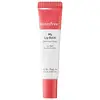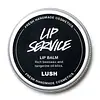innisfree My Lip Balm Versus LUSH Lip Balm
What's inside
What's inside
 Key Ingredients
Key Ingredients

No key ingredients
 Benefits
Benefits

 Concerns
Concerns

 Ingredients Side-by-side
Ingredients Side-by-side

Petrolatum
EmollientHydrogenated Castor Oil Dimer Dilinoleate
Skin ConditioningMicrocrystalline Wax
Emulsion StabilisingBeeswax
Emulsion StabilisingSimmondsia Chinensis Seed Oil
EmollientHelianthus Annuus Seed Oil
EmollientTheobroma Grandiflorum Seed Butter
Skin ConditioningSilica Silylate
EmollientCitrus Aurantium Bergamia Fruit Oil
MaskingCaprylic/Capric Triglyceride
MaskingIsostearic Acid
CleansingDimer Dilinoleyl Dimer Dilinoleate
EmollientDiisostearyl Malate
EmollientTocopheryl Acetate
AntioxidantDehydroacetic Acid
PreservativeCI 77491
Cosmetic ColorantCI 45410
Cosmetic ColorantCitric Acid
BufferingCI 77891
Cosmetic ColorantMentha Piperita Oil
MaskingCI 15985
Cosmetic ColorantSodium Saccharin
MaskingCI 15850
Cosmetic ColorantCI 77492
Cosmetic ColorantTocopherol
AntioxidantWater
Skin ConditioningGlycerin
HumectantButylene Glycol
HumectantCamellia Sinensis Leaf Extract
AntimicrobialCitrus Unshiu Peel Extract
MaskingOpuntia Coccinellifera Fruit Extract
Skin ConditioningOrchid Extract
Skin ConditioningCamellia Japonica Leaf Extract
Skin ConditioningCitrus Sudachi Fruit Extract
Humectant1,2-Hexanediol
Skin ConditioningPetrolatum, Hydrogenated Castor Oil Dimer Dilinoleate, Microcrystalline Wax, Beeswax, Simmondsia Chinensis Seed Oil, Helianthus Annuus Seed Oil, Theobroma Grandiflorum Seed Butter, Silica Silylate, Citrus Aurantium Bergamia Fruit Oil, Caprylic/Capric Triglyceride, Isostearic Acid, Dimer Dilinoleyl Dimer Dilinoleate, Diisostearyl Malate, Tocopheryl Acetate, Dehydroacetic Acid, CI 77491, CI 45410, Citric Acid, CI 77891, Mentha Piperita Oil, CI 15985, Sodium Saccharin, CI 15850, CI 77492, Tocopherol, Water, Glycerin, Butylene Glycol, Camellia Sinensis Leaf Extract, Citrus Unshiu Peel Extract, Opuntia Coccinellifera Fruit Extract, Orchid Extract, Camellia Japonica Leaf Extract, Citrus Sudachi Fruit Extract, 1,2-Hexanediol
 Reviews
Reviews

Ingredients Explained
These ingredients are found in both products.
Ingredients higher up in an ingredient list are typically present in a larger amount.
Beeswax is natural wax produced by honey bees and can be synthetically created. It consists mainly of fatty acid esters and long-chain alcohols.
In cosmetics, beeswax is a emollient. Due to its waxy structure, it creates a protective barrier. This barrier prevents water from evaporating off the skin.
This may not be a good ingredient for oily skin. We recommend speaking with a professional if you have concerns.
Beeswax cannot be removed with water, but can be taken off with an oil cleanser.
Beeswax is also antiseptic and contains vitamin A.
Learn more about BeeswaxGlycerin is already naturally found in your skin. It helps moisturize and protect your skin.
A study from 2016 found glycerin to be more effective as a humectant than AHAs and hyaluronic acid.
As a humectant, it helps the skin stay hydrated by pulling moisture to your skin. The low molecular weight of glycerin allows it to pull moisture into the deeper layers of your skin.
Hydrated skin improves your skin barrier; Your skin barrier helps protect against irritants and bacteria.
Glycerin has also been found to have antimicrobial and antiviral properties. Due to these properties, glycerin is often used in wound and burn treatments.
In cosmetics, glycerin is usually derived from plants such as soybean or palm. However, it can also be sourced from animals, such as tallow or animal fat.
This ingredient is organic, colorless, odorless, and non-toxic.
Glycerin is the name for this ingredient in American English. British English uses Glycerol/Glycerine.
Learn more about Glycerin